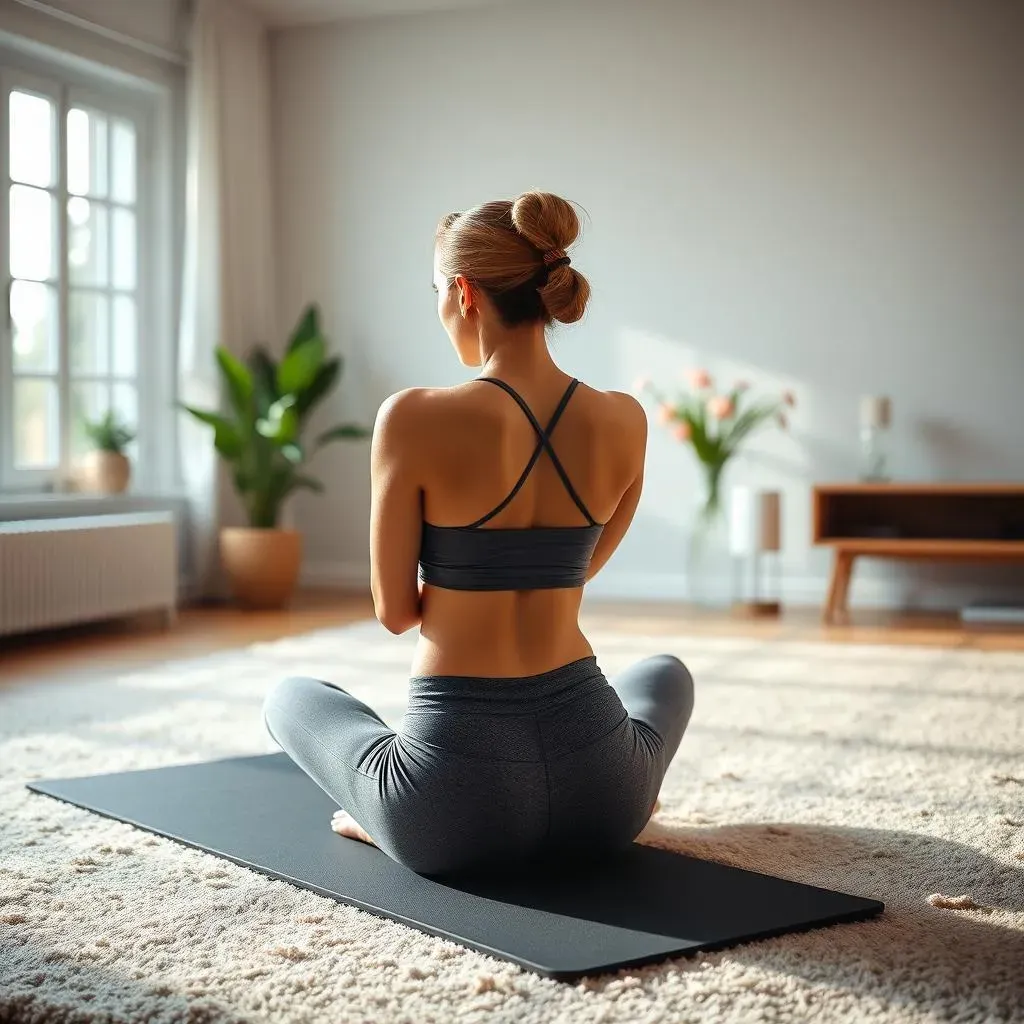Table of Contents
Are you looking for a safe and effective way to strengthen your pelvic floor from the comfort of your own home? Look no further! This article guides you through a comprehensive Pilates workout specifically designed for pelvic floor health. We'll explore the importance of a strong pelvic floor, demystifying this often-overlooked muscle group. You'll learn why Pilates is a perfect choice for strengthening it, and we'll equip you with a series of exercises suitable for all fitness levels – from beginner-friendly moves to more challenging routines for those already familiar with Pilates. Whether you're recovering from childbirth, experiencing incontinence, or simply want to improve your overall core strength and posture, this "pilates workout at home for pelvic floor" guide will empower you to take control of your well-being. Get ready to discover how simple, yet powerful, Pilates can be in enhancing your pelvic floor health and improving your quality of life. We'll cover essential exercises, progression techniques, and important considerations to ensure you're practicing safely and effectively. Let's get started on your journey to a stronger, healthier you!
Understanding Your Pelvic Floor: Why Pilates Matters

Understanding Your Pelvic Floor: Why Pilates Matters
The Unsung Hero: Your Pelvic Floor
Imagine your pelvic floor as a hammock—a vital support system holding your bladder, intestines, and other important organs. It's a network of muscles at the base of your pelvis, and like any muscle group, it needs regular exercise to stay strong and healthy. A weak pelvic floor can lead to problems like incontinence (leaking urine or stool), pelvic organ prolapse (organs slipping out of place), and even back pain. Think of it like this: if your hammock is saggy, everything it's supporting is going to be affected. Strengthening your pelvic floor is crucial for overall health and well-being, especially as we age. For a quick and effective Pilates workout, check out our quick Pilates routine.
Now, you might be thinking, "Kegels are supposed to help with that!" And you're right, Kegels (squeezing and releasing your pelvic floor muscles) are a good start. But Pilates offers something more comprehensive. Pilates isn't just about isolating specific muscles; it's about integrating them into functional movements. This means you're not just strengthening your pelvic floor in isolation, but also improving your core stability and overall body awareness. This holistic approach is key to long-term pelvic floor health and preventing future issues. For beginners, a beginner-friendly Pilates routine is a great starting point.
Problem | Solution |
|---|---|
Weak Pelvic Floor | Pilates |
Incontinence | Pilates |
Back Pain | Pilates |
Why Pilates is the Perfect Partner
Pilates is renowned for its focus on core strength, mindful movement, and breath control. These elements are incredibly beneficial for pelvic floor health. The controlled breathing techniques used in Pilates help to relax and engage the pelvic floor muscles effectively. The emphasis on core stability strengthens the muscles surrounding the pelvic floor, providing support and reducing strain. Unlike high-impact exercises that can put extra stress on the pelvic floor, Pilates is low-impact and gentle, making it suitable for individuals of all ages and fitness levels. Plus, you can do it right at home! If you’re looking to improve your posture along with your pelvic floor strength, check out our guide on Pilates for better posture.
Another advantage? Pilates exercises often incorporate mindful movements, promoting body awareness and connection to your pelvic floor. This awareness is crucial for learning how to properly engage and relax these muscles. This isn’t just about doing the exercises; it's about understanding your body and how to work with it. Over time, consistent Pilates practice will lead to a stronger, more resilient pelvic floor. It's a journey, not a race, so be patient and consistent with your routine. If you're looking for a workout tailored to seniors, explore our Pilates for seniors guide.
- Improved Core Strength
- Enhanced Body Awareness
- Low-Impact, Gentle Movements
- Improved Posture
BeginnerFriendly Pilates Exercises for Pelvic Floor Strength

BeginnerFriendly Pilates Exercises for Pelvic Floor Strength
Getting Started: Simple Moves for a Stronger Pelvic Floor
Let's ditch the complicated stuff and focus on building a solid foundation. These beginner-friendly exercises are your gateway to a stronger pelvic floor. Remember, consistency is key! Start with a few repetitions of each exercise, gradually increasing as you feel stronger. Listen to your body; if something feels wrong, stop and consult a healthcare professional. For a more detailed beginner's guide, check out our beginner Pilates workout.
First up: the Pelvic Tilt. Lie on your back with knees bent and feet flat on the floor. Gently tilt your pelvis, flattening your lower back against the floor. Hold for a few seconds, then release. This simple exercise strengthens your deep core muscles, including your pelvic floor. Next, try the Bridge. Start in the same position, then lift your hips off the floor, squeezing your glutes and pelvic floor. Lower slowly. This works your glutes and hamstrings, supporting your pelvic floor. For a quick workout, try our quick Pilates routine.
- Pelvic Tilt: Flattens your lower back, engages core.
- Bridge: Lifts your hips, strengthens glutes and hamstrings.
Adding More: Building Strength and Stability
Once you're comfortable with the Pelvic Tilt and Bridge, let's add some more exercises to challenge your pelvic floor. The next step is incorporating leg movements. Try Single Leg Circles. Lie on your back, knees bent. Extend one leg towards the ceiling and make small circles with your leg, keeping your core engaged. This exercise strengthens your deep core and improves stability. Another great option is the Double Leg Stretch. Lie on your back, hugging your knees to your chest. Extend your legs and arms simultaneously, maintaining your core engagement. This exercise improves coordination and works your deep abdominal muscles. If you're looking for a more comprehensive routine, our effective Pilates workout has more options.
Remember, proper form is crucial. Focus on engaging your pelvic floor throughout each movement. Don't rush; slow and controlled movements are more effective than quick, jerky ones. Consistency is key to seeing results, so aim for regular practice, even if it's just for a few minutes each day. For those interested in using resistance bands, check out our guide on Pilates with resistance bands.
Exercise | Focus |
|---|---|
Single Leg Circles | Core Stability, Leg Strength |
Double Leg Stretch | Coordination, Deep Abdominal Engagement |
Intermediate & Advanced Pilates Moves for a Stronger Pelvic Floor

Intermediate & Advanced Pilates Moves for a Stronger Pelvic Floor
Challenging Your Pelvic Floor: Stepping Up the Intensity
Now that you've mastered the basics, let's crank up the intensity! We'll introduce more challenging Pilates exercises that further strengthen your pelvic floor and improve your overall core stability. Think of these as the next level in your fitness journey. Remember to listen to your body and modify exercises as needed. Don't push yourself too hard, especially when starting. A gradual progression is key to avoid injury and build sustainable strength. For example, the Criss-Cross exercise involves twisting your torso while keeping your core engaged, deeply engaging your pelvic floor muscles. If you find you need additional support, check out our guide on Pilates with resistance bands for some extra challenge.
Another fantastic exercise is the Teaser. This involves a controlled movement from a lying position to a seated position, engaging your entire core, including your pelvic floor, throughout the movement. It requires balance, coordination, and core strength, making it a true test of your fitness. The Hundred, a classic Pilates exercise, involves rhythmic arm movements while maintaining core engagement and controlled breathing. This exercise is excellent for building core endurance and strengthening the deep abdominal muscles that support the pelvic floor. If you are over 50, check out our Pilates for over 50s guide for modifications.
- Criss-Cross: Torso twists, deep core engagement.
- Teaser: Controlled movement from lying to seated, full core engagement.
- Hundred: Rhythmic arm movements, core endurance.
Integrating Pilates into Your Lifestyle: Consistency is Key
At this stage, it's not just about the exercises themselves, but also about integrating Pilates into your daily life. Think of it as a holistic approach to wellness, not just a workout. Consistency is paramount to building a strong pelvic floor and maintaining long-term benefits. Aim for regular sessions, even if it's just for 15-20 minutes each day. This consistency will yield far greater results than sporadic intense sessions. Consider adding a Pilates session to your morning or evening routine, making it a non-negotiable part of your day. This approach transforms Pilates from a chore into a self-care ritual. For a shorter routine, check out our 20-minute Pilates workout.
Remember, it's okay to modify exercises to suit your individual needs and fitness levels. If you're feeling any pain, stop immediately and consult with a healthcare professional. They can provide personalized guidance and ensure you're practicing Pilates safely and effectively. As you progress, you can increase the intensity and duration of your workouts, gradually pushing your limits and building even greater strength and stability. If you are aiming for weight loss, our Pilates for weight loss guide can help.
Tip | Benefit |
|---|---|
Consistent Practice | Sustainable Strength |
Listen to Your Body | Injury Prevention |
Gradual Progression | Long-Term Results |
Advanced Pilates for a Powerful Pelvic Floor
Ready to push your limits? Advanced Pilates exercises demand greater control, strength, and balance. These moves build upon the foundations you've established, taking your pelvic floor strength to the next level. We're talking about exercises that challenge your core in new and exciting ways, demanding precision and focus. For example, the Side Kick Series strengthens the outer hip muscles and improves stability, which is crucial for pelvic floor support. These exercises are more demanding, requiring a strong understanding of Pilates principles and body mechanics. Therefore, it's recommended to have some prior Pilates experience before tackling these advanced moves. If you want to work on your abs, check out our Pilates for abs guide.
Another advanced exercise is the Spine Stretch Forward, which improves spinal flexibility and enhances core strength. This exercise engages the deep abdominal muscles, which play a vital role in supporting the pelvic floor. Remember that proper form is crucial when performing advanced Pilates exercises. Focus on maintaining correct alignment and engaging your pelvic floor throughout each movement. If you’re unsure about your form, consider taking a Pilates class with a qualified instructor. They can provide personalized feedback and guidance, ensuring you're practicing safely and effectively. For a workout focusing on strength, check out our Pilates for strength guide.
- Side Kick Series: Strengthens outer hip muscles, improves stability.
- Spine Stretch Forward: Improves spinal flexibility, enhances core strength.
Maintaining a Strong Pelvic Floor: Tips and Considerations

Maintaining a Strong Pelvic Floor: Tips and Considerations
Lifestyle Choices for a Healthier Pelvic Floor
So, you've learned some awesome Pilates moves. Fantastic! But maintaining a strong pelvic floor isn't just about exercise; it's about your whole lifestyle. Think of it like this: you wouldn't expect a car to run smoothly on bad gas, right? Similarly, your pelvic floor needs the right fuel and care to function optimally. A healthy diet, rich in fruits, vegetables, and fiber, supports overall bodily function, including your pelvic floor. Staying hydrated is also key; adequate water intake helps prevent constipation, which can strain your pelvic floor. For a workout targeting your core, check out our core strengthening Pilates routine.
Maintaining a healthy weight is another crucial factor. Excess weight puts extra pressure on your pelvic floor, increasing the risk of issues like incontinence. Regular exercise, beyond Pilates, helps maintain a healthy weight and overall fitness. Remember, a balanced approach is key. Don't just focus on your pelvic floor; nurture your entire body! For a relaxing Pilates session, check out our relaxation Pilates routine.
- Hydration
- Healthy Diet
- Weight Management
- Regular Exercise
Addressing Specific Concerns
Let's talk about some common concerns. Postpartum recovery is a big one. After childbirth, your pelvic floor needs extra TLC. Gentle Pilates exercises, tailored to your recovery phase, can help rebuild strength and prevent long-term issues. Always consult your doctor or a physical therapist before starting any postpartum exercise program. They can provide guidance and ensure you're doing things safely. If you're looking for a workout suitable for seniors, check out our Pilates for seniors guide.
Another frequent concern is incontinence. This can range from minor leaks to more significant issues. Pilates can be incredibly helpful in strengthening your pelvic floor and improving bladder control. However, if you're dealing with severe incontinence, it's essential to consult a healthcare professional. They can assess your situation, rule out any underlying medical conditions, and recommend appropriate treatment options. For a Pilates routine focused on improving posture, check out our Pilates for posture guide.
Concern | Action |
|---|---|
Postpartum Recovery | Consult doctor, gentle Pilates |
Incontinence | Consult doctor, targeted Pilates |
Consistency and Patience: The Long Game
Building a strong pelvic floor is a marathon, not a sprint. It takes time, patience, and consistent effort. Don't get discouraged if you don't see immediate results. Celebrate small victories and stay committed to your routine. Consistency is key to building lasting strength and improving your overall well-being. Remember, it's a journey, not a destination. Enjoy the process, and be kind to yourself along the way. For a workout that can be done without equipment, check out our no-equipment Pilates routine.
Finally, remember that Pilates is just one piece of the puzzle. Combine your Pilates practice with a healthy lifestyle, including mindful eating, regular exercise, and stress management techniques. This holistic approach will not only benefit your pelvic floor but also enhance your overall health and well-being. For a Pilates routine focusing on flexibility, check out our Pilates for flexibility guide.
